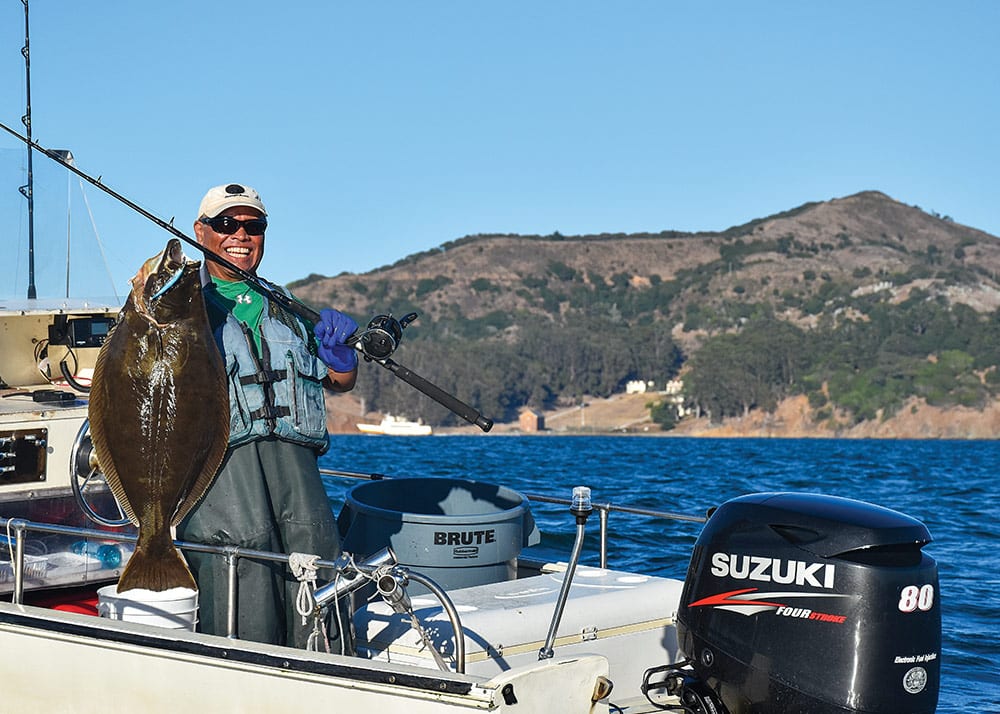
As we troll the flats west of Berkeley in nearly wadable water, to our south the newly minted San Francisco- Oakland Bay Bridge glints in the morning sun, with the Richmond-San Rafael Bridge to the north. Despite being in the center of a busy urban environment, the fishing is good. Literally within minutes of our gear tapping down we get a violent strike.
This fish, no couch potato, streaks off on a spirited run. Luckily, the hooks hold as I ease a 15-pound California halibut toward the net. My brother Julius makes a deep scoop, and from there this thrashing doormat goes into a large cooler. The audible thumping is music to our ears, and it gets louder as we eventually add five more halibut. We played the tides right to limit out, but success also came about because we were using a simple but effective technique: dragging plugs in the bay shallows.
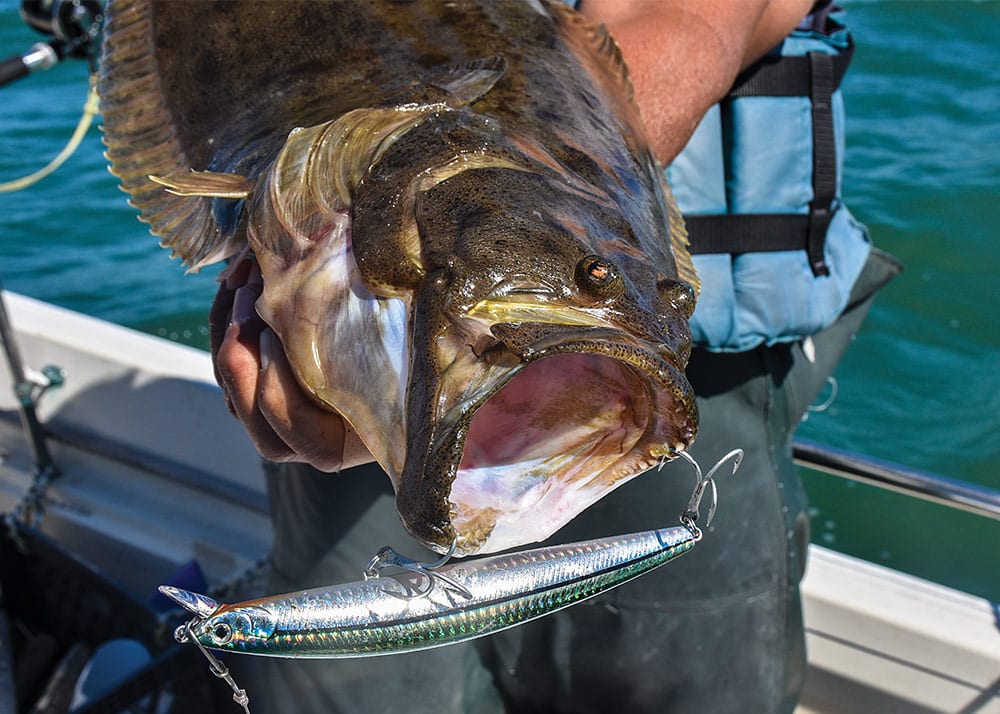
Mobile Predators
Despite their odd shape, California halibut are in fact mobile predators and will rise well off the bottom to feed. This is especially true from spring through fall as bait schools invade San Francisco Bay. During these periods of abundance, however, halibut can get picky, so you need to trigger their predatory response. That’s when plugs can be deadly.
Lipped diving plugs, with their alluring flash and vibration when cast or trolled, take many species of inshore and offshore game fish, and, not surprisingly, they will also take California halibut. Best of all, with plugs there’s no fuss or muss; they’re versatile, and you just plunk them down and they catch fish.
Halibut are always moving, so plan on covering some water to stay in the action. Sometimes I’ll start shallow and work deeper, or vice versa, but once you find that hot depth lane, mark it down. Halibut will also set up along irregular tidal edges, so when you see one developing, troll along its edge. Halibut are rarely alone and will aggregate over a specific area.
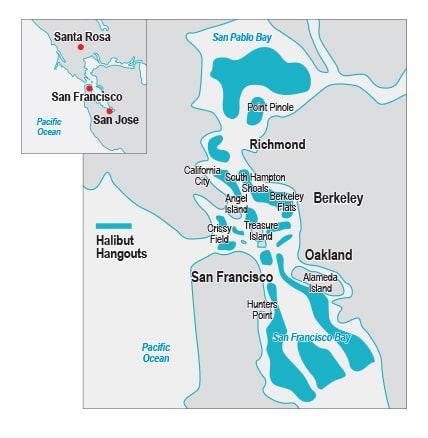
Halibut Territory
Fortunately, there’s a lot of territory where plugs can be deployed. The waters from San Pablo Bay in the north down to South San Francisco Bay hold prime halibut regions. Here anglers need to search out target zones that will hold halibut consistently. Productive bottom features a mix of firm sand and shell, mud flats and shell banks. And if this material is stretched across gradual mounds, depth changes, or channel edges that hold bait, your odds increase dramatically.
Halibut in the bay inhabit depths from 5 to well over 30 feet. Weak to moderate tides are preferred on both the incoming and outgoing, and generally the best action occurs during the short window when the current begins to speed up or slow down.
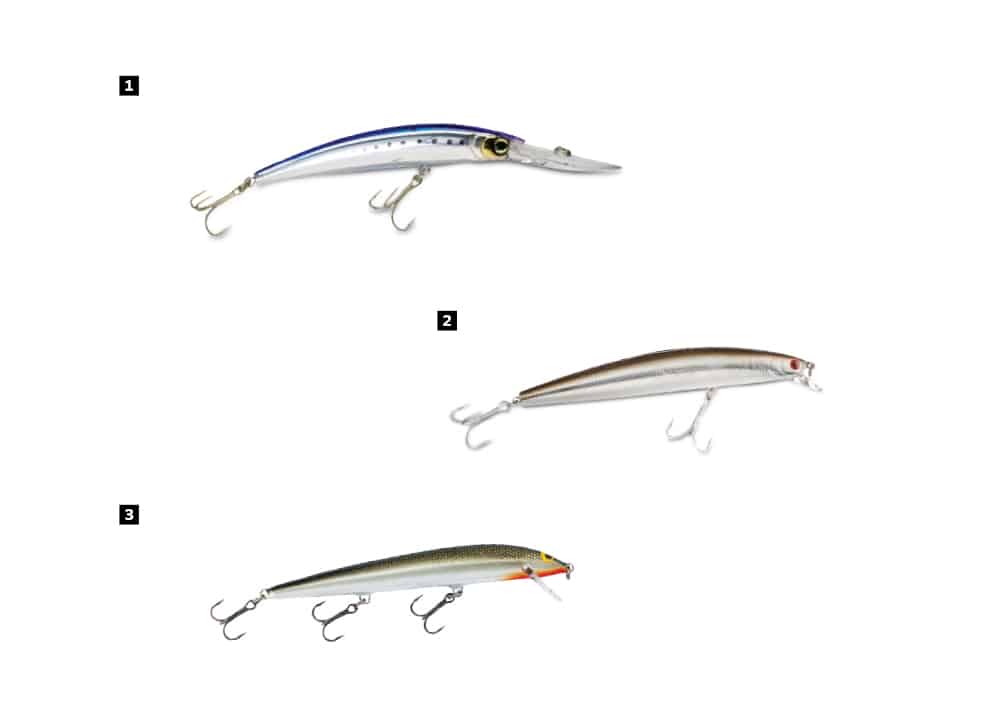
[2] The Daiwa SP Minnow maintains action over shallower halibut habitat.
[3] For middepths, choose a moderate-depth runner, such as a Bagley Baits Bangolure. Courtesy Yozuri, Daiwa, Bagley Baits
Plug choices
Plugs designed for shallow running, when rigged with a sinker, can be fished in varying depths. When fish are in skinny water, say 10 feet and less, I’ve had a lot of fun fishing deep-diving plugs minus any weight. When using deep divers, I drop them back until I feel the lure tick bottom and pick up a turn or two on the reel. At times you’ll have to bump up the troll speed a bit more to make them dive down properly.
Some of the most effective plugs include the Yo-Zuri Crystal Minnow in the 51⁄4-inch size, Daiwa SP Minnow Floater in the 51⁄8- and 6-inch sizes, and the 51⁄4-inch deep-diving Bagley DB06. All of these plugs produce in natural bait colors, but when the water becomes murky, colors ranging from chartreuse, red-and-white, and bright orange will generate strikes.
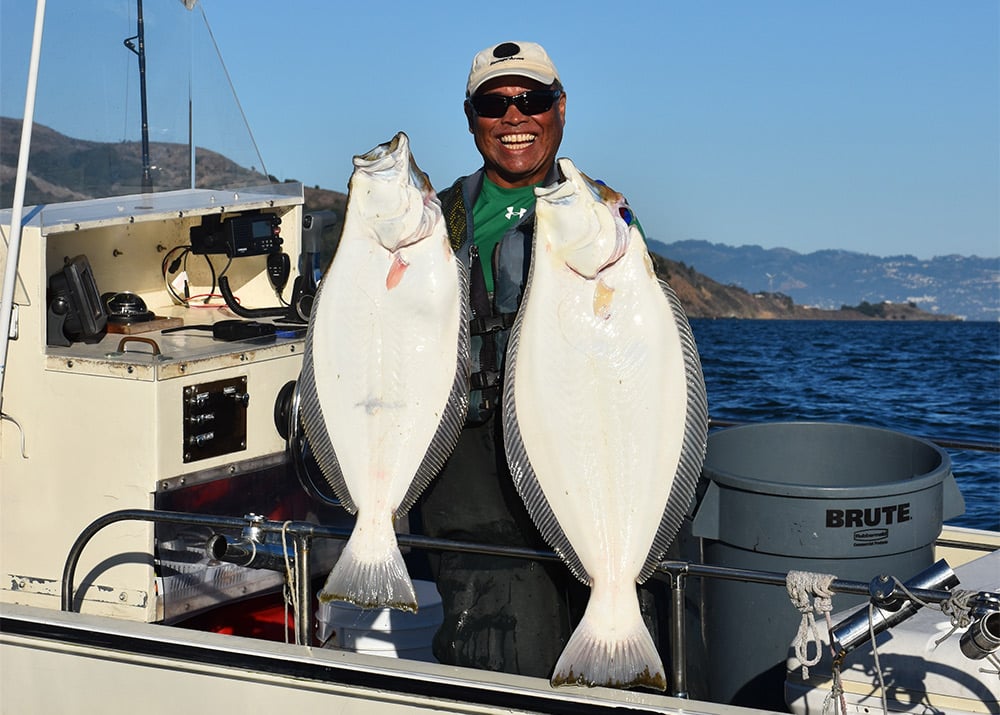
Troll Tips
Sport anglers can only fish one line each in San Francisco Bay. When you do have extra company, it’s important to stagger the lines properly to minimize tangles and create an effective spread. For a four-line system, load the close lines with heavier sinkers and rig the longer lines with lighter weights.
I always get more strikes by facing into the current or crossing the current, as opposed to moving straight down with the flow. If I get a short hit or a solid hookup, I get GPS numbers on the spot. You’ll find that other fish can be near this original point of action, and once the bite does kick in, it goes off in short bursts. Keep hitting that section by repeatedly cross-trolling in wide, gradual back-and-forth arcs, or you can swing down-current and then move up-current through that section. Obviously, when the bite dies, troll to a new area.
Productive troll speed can vary from about 2 to 3½ knots, particularly when dealing with some uphill chop. Once you’ve determined the hot depth and the amount of weight to use, drop line back until the sinker is ticking bottom occasionally, and then lock up the reel.
Watch Tips
If the rod tip is vibrating consistently, that indicates the plug is working properly. If it’s not, that means it’s loaded with bottom growth or an undersize halibut is hanging on. Check the plug and clean the hooks off. In recent years, we’ve had a huge infusion of shaker halibut in the bay, so when you get one on, release it carefully.
Traditional baits, like anchovies and herring, will take halibut as well, but when you have those periods when the drone of the engine is putting you to sleep and your current arsenal lacks that needed spark, try dragging plugs. The results can be adrenalin-inducing.
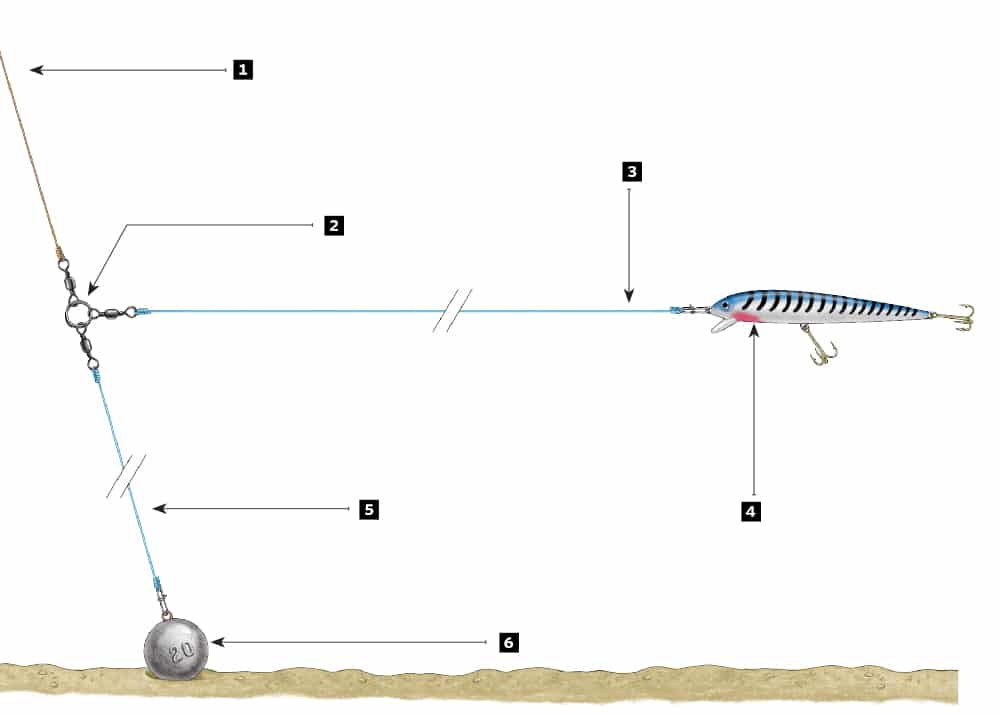
[2] Three-way swivel
[3] 50-pound fluoro
[4] Lipped plug
[5] 60-pound dropper line
[6] 6- to 40-ounce cannonball sinker Steve Sanford
SWS Planner: California Halibut
What: California Halibut
Where: San Francisco Bay
When: April to early November
Who:
Capt. Trent Slate
Bite Me Charters
415-307-8582
bitemecharters.net
Capt. Christian Cavanaugh
Big C’s Charters
chasincrustacean.com
Capt. Jay Lopes
Right Hook Sport Fishing
righthooksportfishing.com
SWS Tackle Box: California Halibut
Rod: 7-foot rod with a live-bait action rated for 10- to 25-pound line, such as Cousins F270 and F870
Reel: Conventional, such as Penn 320 and 330 GT levelwind
Line: 200 yards of 50- to 80-pound braid, such as P-Line, Berkley or Tuf-Line
Lures: Yo-Zuri Crystal Minnow, 51⁄4-inch shallow runner and deep diver; Daiwa SP Minnow Floater, 51⁄8- to 6-inch; Bagley Deep Diving DB06,
51⁄4-inch
Regulations: Anglers are allowed to fish one line and are permitted to keep three halibut 22 inches or larger per day in San Francisco Bay. Always check local CDFG regulations before heading out at wildlife.ca.gov.









